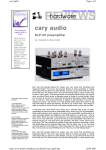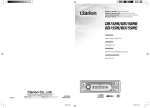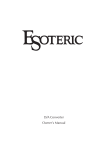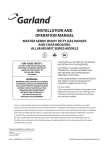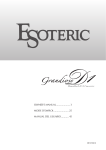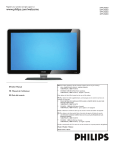Download Esoteric P-03 CD Transport and D-03 D/A Converter
Transcript
Esoteric P-03 CD Transport and D-03 D/A Converter Arnis Balgalvis T Reprinted from The Audiophile Voice Vol. 12, No. 2 EAC IS ABOUT AS WELL-KNOWN a name in consumer electronics as there is. But if you are looking for cutting edge audiophile equipment within the Teac world, their Esoteric division is where the truly hot action is. That’s where some of today’s most-advanced and best-executed high-end equipment is being conceived and produced. With the introduction over the last couple of years of some very sophisticated products like the two I am reviewing here, Esoteric has firmly established a name for itself in audio’s upper echelon. From what I have observed, Esoteric does their best work when it comes to CD playback products. They are the same folks who, some 20 years ago, set the CD playback world reeling when they unleashed the T-1 VRDS CD Drive Unit (CD Transport to everyone else). With the introduction of the VRDS technology (that’s Vibration-free Rigid Disc-clamping System), Esoteric took a huge step forward in quality CD playback. It can be argued that to this day the Esoteric VRDS transports remain the standard by which all other transports are measured. Why else would companies like Spectral and Wadia buy the VRDS transport mechanism for inclusion it in their own products? As their latest wrinkle, Esoteric has upgraded the VRDS CD transport to the VRDS-NEO level. This step was thought necessary not only to address the needs of SACD playback, but also because it would significantly improve playback of the standard Red Book CDs. After I heard the $50,000 Teac flagship P-01 CD transport and the dual mono D-01 DAC combination at the 2005 CES, I wrote in my Show report: “To me, this was the very best sonic performance, at any CES, so far in this century.” I still think that demonstration was one of the most exhilarating CES experiences ever. The Esoteric P-03 SACD and CD transport and D-03 D/A converter reviewed here are directly derived from their two very expensive flagship units. Both of the “03s” are very closely related to “01s” technically and aesthetically, but the prices of the P-03 and D-03 are significantly lower, though not at pocket-change levels, with MSRPs of $13,200 each. The P-03 and the D-03 are styled and executed with an elegant to-die-for look, right along the lines of the Big Brother units. Just like the P-01 and the D-01 jewels, the P-03 and the D-03 sport a champagne-hued anodized finish with the front and side panels showing a brushed texture, while the top panel is sandblasted. The resulting presentation is simply breathtaking. But let’s take a deep breath here. As gorgeous as these units are appearance-wise, their great looks are Volume 12, Issue 2 To round out its versatility, the P-03 will also accept an external clock on its BNC-type “Word Synch” input connector, for frequencies of 44.1, 88.2, 176.4 and 100 kHz. Unlike the P-01, which sported a separate power supply, the P-03 transport is configured to be a single box unit. The power supply components are contained in a carefully isolated separate compartment within the main housing, making it a part of the P-03 chassis. P-03 not the main feature. These units have been designed with only one purpose in mind – technical excellence. And that is where they shine – as you will see, they provide positively brilliant performance. When viewing the overall stellar performance picture, what stands out is their versatility. Esoteric has seen fit to provide a bevy of desirable options to the user to accommodate personal tastes, variations in recording quality, music preference, and the wide variety of playback equipment likely to be encountered. The P-03 Transport To me, the P-03 transport with the upgraded VRDSNEO disc-clamping system is an absolute electromechanical marvel, the pinnacle of Esoteric’s electromechanical offerings. I cannot think of another more sophisticated or better-executed product in all of highend audio. When it comes to output protocol and interface choices – choices that permit getting the best performance out of the P-03 or setting it up to optimally interface with other DACs – the P-03 transport is the most versatile and flexible CD playback component offered by Esoteric to date. It has “Anything you can do, I can do better!” written all over it. Want to play a Red Book CD? Take your choice of outputs. The P-03 will give you AES/EBU on an XLR connector, SPDIF on an RCA connector, Dual AES on dual XLR connectors, and iLINK (IEEE 1394 or “Firewire”) on its dedicated iLINK interface connector. How about SACD? It’s ready! For delivering SACD data, Esoteric provides a choice of two output formats: the industry standard IEEE 1394 iLINK, usually known as “Firewire,” or ES-LINK, a proprietary Esoteric-exclusive protocol. This iLINK uses its own dedicated connector, while the ES-LINK relies on the dual XLR outputs. What about using another DAC with the P-03? Can do! The P-03 will support AES/EBU or Dual AES/EBU, or SPDIF on the dual XLR or RCA digital output connectors, respectively. Yeah, but how about using the P-03 with another SACD capable DAC? Ready and able, as long as the other DAC has an iLINK or “Firewire” interface. But there’s more. The P-03 can up-convert to 44.1 kHz, 88.2 kHz, and 176.4 kHz rates in addition to providing a digital filter off mode at 44.1 kHz. How about up-sampling to the DSD rate? Absolutely! As probably the only equipment to offer this choice, the P-03 features PCM-to-DSD conversion functionality for Red Book CD playback. With a DSD rate of 64f or 2.8224 MHz, this makes it the highest up-conversion rate available in the industry today. NEO, Not Just A Three-Letter Word The NEO version has been designed to fulfill a new set of requirements. For one thing, since the P-03 has to accommodate SACD discs, the CD turntable holding the disc needs to attain rotational speeds 4.5 times higher than what a standard CD requires. To that end, Esoteric selected duralumin, a relatively new low-mass metal originally developed for use in the aircraft industry as the material for their new CD turntable. To do this, they had to solve some demanding machining challenges presented by this new material. Furthermore, the designers felt they wanted to have the turntable surface assume a new shape. This surface now is slightly concave, so that when the disc is being played, and thus is clamped to the turntable at its center portion, it assumes a slightly concave contour. This shape was implemented to precisely maintain the optical axis of the laser pick-up with that of the pit surface of the CD during playback. To spin the CD disc, the Esoteric engineers created a long-life, three-phase, brushless spindle motor using new high-precision ceramic bearings. The new bearings were newly developed exclusively for the P-03 and allow the turntable to spin with extreme rotational stability and smoothness. Another new motor, a Hall-element sensing type, and also a brushless design for long life, was chosen to drive the P-03 laser pick-up sled along a rigid shaft. This critical process keeps the laser sled precisely positioned as it traces the CD’s bit track at its very center. I just want to remind you here that the width of a CD bit track is roughly 1/20th of the width of a human hair. The sled motor is controlled by highspeed, high-current servos to maintain accurate tracking and to also provide very fast access speeds. The whole VRDS NEO turntable mechanism is supported by a 20-mm thick bridge structure made of SS400 steel, and the bridge alone weighs 3.75 lbs. Structural integrity of this order contributes significantly to the creation of a rigid and resonance-free environment, something of utmost importance when trying to accomplish the playback process with state-of-the-art accuracy. The P-03 CD tray is a joy to watch and use. It glides out in the quietest, smoothest manner I know of. Up to now, the Linn CD-12 had the smoothest drawer, but the P-03 is now my new “slide and glide” reference. For a crowning touch, the P-03 transport is equipped with a shutter mechanism for the CD tray opening. Whenever the CD tray is summoned to the “Open” position, the shutter internally pivots out of the way, and closes once the tray has retracted into the housing. This shutter not only keeps dust out, but it also prevents potentially adverse internal sounds from escaping from the transport’s inner sanctum during playback. In its closed position, the shutter is rendered inert as it is secured very snuggly against the player’s front panel. the audiophile voice The D-03 D/A Converter Teac offered their all-out D-01 as a “mono block” DAC so that a pair of them was required for stereo applications, and additional units would be needed to meet surround-sound or home theater demands. The D03 DAC also features two identical monaural D/A converter channels, but both are consolidated in a single chassis. Additionally, each of the D/A converter channels features its own dedicated power supply. The D-03 DAC is capable of accepting any known digital input and can handle all of the protocols that the P-03 transport provides on a corresponding set of connectors. For good measure, it has an additional RCA SPDIF, as well as, a TOSLINK input. The D-03 contains its own internal high-precision VCXO crystal-clock oscillator, accurate to +/-0.5 ppm, for synchronizing external transports such as the P-03. In the clock “Out” mode, the output is available on a BNC connector. In the clock “In” mode, an input for external clock synch rates of 44.1, 88.2, 176.4, and 100 kHz is provided on a second BNC connector. The D-03 gives the user the choice of turning the oversampling digital filter “On” or “Off.” In the “On” mode, the digital signal is up-converted eight times before the D/A conversion. No up-conversion takes place in the “Off” mode. This choice gives the user the ability to tailor the sound to suit the environment or taste. The heart of the digital-to-analog conversion process for the D-03 is the Analog Devices AD 1955 multi-bit Sigma-Delta DAC chip set, with several of them implemented in a differential mode. The 24-bit, 192-kHz AD 1955 chip is a very versatile device, capable of processing PCM and SACD bit-stream digital signal formats. Also at work in the D-03 is the Esoteric RAM-Link circuit, a buffer which reclocks digital audio signals to reduce jitter from ordinary reclocking by using its own internal, high-precision master clock. As newly configured for the D-03, Esoteric’s RAM-Link circuit has been upgraded to handle DSD as well as PCM signals. WBT “Nextgen” RCA sockets, executed in gold-plated pure copper, are used for the SPDIF Digital Input connectors. These connectors have a true 75-ohm characteristic impedance. The analog circuitry in the D-03 has been executed using only hand-selected discrete parts. No audio chipsets are to be found here. Discrete circuit component choices were made to achieve the highest audio signal purity for the critical audio path. I’ve said it before, and I’ll say it again: Analog can make or break digital, but not vice versa. All analog circuitry is judiciously separated from the vicinity of power supply components to avoid contaminating the analog signal by stray fields and interference. Of note is the layout pattern for the analog audio circuitry, which is identical for both the left and right channels. This symmetry avoids any problems generated by dissimilar signal paths and component placement. All internal wiring uses “six nines” copper conductors. The stereo audio outputs of the D-03 DAC appear on a pair of XLR connectors for balanced signals, and a set of WBT-0201 RCA connectors for single-ended signals. Sound and Solid Foundation The overall mechanical design of both of these products has resulted in an exceptionally rigid and non-resonant chassis. Esoteric has strived to achieve a mechani- cal environment where sympathetic vibrations and other undesirable disturbances are kept to a minimum. They refer to this approach as a “highly rigid integrated one-piece body style.” In order to provide a firm foundation for the precision mounted component parts, each of the P-03 and the D-03 chassis starts out with a 5-mm thick steel bottom mounting plate which weighs about 13 pounds. Next, they incorporate massive aluminum front and side panels which are further reinforced by a set of rounded corner pillars. And finally, an 8-mm thick cover plate, also aluminum, completes the enclosure structure. Each chassis is supported by three quenched steel pinpoint isolation feet, which are intended to “quarantine” the units from unwanted external structural vibrations and provide support the 66-pound P-03 transport and the 59.5-pound D-03 DAC. Setting Up During the evaluation period the two components were placed on a very sturdy and quite inert support base, with the P-03 sitting on top of the D-03. I did not experiment with alternate placement of these components mainly due to their very brawny weights. Neither did I play with a.c. power cords; Teac supplied a set of a.c. cords and that is what I used. Please note that the Teac does not provide a grounding conductor in these a.c. cords. They do provide grounding posts on each chassis and these can be connected to a common single-point ground. Except for the weight, no problems were encountered during my evaluation period. Considerable effort was called for when the units were unpacked from their very well-designed custom packing cartons. Once connected, they commenced to play in a very exemplary fashion. For this evaluation, to synchronize the P-03 transport and the D-03 DAC, Esoteric provided their stunning G0s Rubidium Master Clock, which is an exceptionally stable external clock-standard unit, accurate to 0.05 parts per billion. Need I say more? You should understand that the G-0s clock is an option. In a normal set-up, the D-03 will output a synch signal provided by its own high-precision crystal clock oscillator. This D-03 clock, accurate to +/-0.5 ppm, is used to slave operation of the P-03 to this premium single clock source in order to reduce jitter to as low a level as possible for improved playback. Being that the D-03 has fixed-output analog stage, a preamp has to be used with it; it follows that the overall performance will be at the mercy of the preamp that follows the D-03. For this evaluation, I used my JRDG Synergy IIi preamp with the JRDG BPS-2 battery power supply. Getting the battery power supply for Synergy IIi has been one of the best audio moves I ever made. This set-up allows me to completely remove the a.c. line from the preamp, thus rendering it totally immune from any interference or noise floating on the line. I just pull the plug of the BPS and the preamp is powered solely by the battery. I have had this preamp operate for more than 24 hours on the battery alone and have not detected any problems sonically even after such an extended period of time. With only the battery in place, the Synergy IIi becomes exceptionally quiet, more transparent, and far more dynamic. And this is exactly what is needed to evaluate the performance of top-tier equipment like the D-03. Volume 12, Issue 2 Area,” they are talking about the SACD and CD layers of the CD disc. I had nothing but pleasure and fun using these units. They were easy to use and I was quite taken by their many flexible options. The P-03 and D-03 were the most sophisticated and refined high end products to ever play in my system. The Sound, The Whole Sound, And ... D-03 Only Meant for Each Other? The P-03 and D-03 units have obviously been designed by Esoteric to complement each other. Oh sure, they might be used separately with different components. I can attest to that. And they will perform superbly. But since the up-conversion and clocking functionality offered by the P-03 and D-03 is unique to Esoteric products, a significant portion of the performance capability and synergy occurs when the two units are used in tandem, and this performance level can potentially be compromised if either item is used with other equipment. One important caution when starting out with these new pieces right out of the box: Let the units cook for a while before listening critically. What’s “a while”? I suggest letting them play 24/7 for at least two weeks. Ideally, put in a CD, hit “Repeat,” and leave the units be. Of course, there’s no audiophile I know who is capable of such detachment, not when dealing with equipment at this performance and price point. Maybe you know some guys like this, but I don’t! Everybody I know will be strongly inclined to rush to hear the units as soon as possible. But the equipment is not ready! So, be patient and do the right thing. I would also suggest that you do read the manual. And do that closely! As I mentioned, these are very sophisticated and exceptionally flexible units. In order to get the most out of them, they have to be configured properly. Knowledge of the manual will be a great help. For instance, you can up-convert when Red Book CDs are played. But since this function resides in the P-03 transport, the D-03 DAC has to be set to receive the upconverted data. Also note, that while SACD audio playback can be accomplished via the iLink or the dual ESLINK connection, iLINK will not support any up-converted data above 44.1 kHz even though it will pass the SACD data. The most flexible connection for two-channel audio appears to be the dual XLR configuration. This will support up-conversion starting at 88.1 and going up to the DSD rate. It will handle SACD playback as well. The manual is quite clear in explaining all of the iterations and it covers a number of other important functions. The remote is handy and provides all of necessary control commands for most of the necessary functions. It even includes the ability to dim the displays and LEDs from the listening position, a very nice touch. Backlighting isn’t included but would have been nice, though. Just remember, when Esoteric refers to “Play Evaluating the Esoteric P-03/D-03 pair provided me with countless marvelous listening sessions. That should not come as a surprise – after all, this is uncommonly great equipment. In all fairness though, the many instances when I sat there, captivated by the stunning musical spectacles unfolding in front of me, really did not qualify as “listening sessions.” These were times when music was the featured attraction; this was enjoyment time, pure and simple. Because the musical events were presented in a vivid and relaxed manner, a very engaging sonic setting was created. I was listening to sounds so refined, delicate and dynamic that I would often get carried away and, you guessed it, listen far into the night. What I heard was clear, clean, and very pure, a free and easy flow of music within a seemingly boundless soundspace. Those were the days! Evaluation was the furthest thing from my mind. But real is real. Esoteric did not provide me with $26,400 worth of gear just so I could have some fun. The name of the game here is evaluation. For starters, let me look at the performance picture in broad strokes. In all my listening did I get a resolved 3D soundstage? Yes, I did. Was the gear good at communicating musical values? Absolutely! How about detail retrieval and instrumental tonality? Yes and yes! An expansive soundspace? All there, in spades! Dynamic contrasts? Done! Evenly distributed spectral response? All the way! Staging? As good as it gets! Soundspace? Totally immersing! You name it, the P-03 and D-03 could do it. But as I was listing all these sonic characteristics, it occurred to me just how little they convey about the whole performance picture when singled out separately. At this level of performance, it’s not the quantity of positive sonic characteristics that counts, but the overall manner in which they are presented. What counts is the degree of refinement and finesse. And in this important aspect, the Esoteric equipment just plain shines. We are not talking about a nuance here or a detail there. The improvement is far more global than that. For example, because the advances are conveyed in a very finely measured way, recordings on the whole become much more enjoyable. The laterally delineated width, the dimensional depth, all accented by superb definition and fast response, produce an absolutely stunning sense of musical engagement. When all was said and done, a very life-like sonic panorama materialized. Orchestral assaults are easily perceived as awesome and decidedly reminiscent of the feeling at a live performance where loud is never too loud. Get too loud at home and we usually reach for the remote. But with the Esoteric gear, this was not the case. Here, the musical presentation I encountered rarely peaked out due to the equipment. Play clean material, and it will be recreated accordingly. As a result, my playback volume had a tendency to get louder for some of the more boisterous the audiophile voice selections. Conversely, when delicate material was involved, the volume could be turned way down without losing resolution. With the level of execution the Esoteric engineers and designers have achieved, everything occurs at a refined plateau. I observed that seemingly small changes could result in very positive performance increases. For example, take system noise floor. I have found that the lower it is, the more abundant the details. It is very thrilling to have the music materialize from what appears to be a very dark and empty sonic space. With this sense of stillness as the backdrop details are allowed to emerge and are perceived in very stark relief. Being more aware of all this “small stuff” accents our sonic involvement. The P-03 and D-03 went a long way to stage this background of black nothingness. I found that I was able listen into the music and the performance to a newfound degree. It also seemed to be an added benefit when listening at lower volume settings. The music appeared to be more welcoming, more inviting. More of the core values of music reproduction were brought out in a far more discernable manner. I observed first-rate transparency and the performers were revealed to have more presence. The midrange was simply exquisite. Bass was more defined and at the same time more forceful. Nothing like good, clean heft. There was no performer or instrument that was not revealed in an new and enjoyable light. The whole soundstage was “alive with the sound of music.” All this emphasis on definition and detail might lead some to suspect that this equipment is overtly analytical at the expense of musical values. Not so by a long shot! The P-03 and D-03 did an elegant balancing act when it came to dealing with the analytical and musical aspects of performance. So much so, that in all my listening, neither aspect made itself conspicuous at the expense of the other. I actually never questioned it. It only became a consideration during the evaluation process when it occurred to me to bring it up for the sake of clarity. During their extended stay with me, this Teac equipment delivered exceptional performance every day of the week and every hour of the day. Some say familiarity breeds contempt, but this was absolutely not the case here. I have gained nothing but the highest respect for these pieces, a respect that increased the longer I had the equipment. Time and time again, this equipment demonstrated an uncanny ability to delve into the music in a most resolving manner and to come up with an astounding amount of newfound musical details. These details appeared very naturally combined and culminated in a display of an exceptionally engaging sonic panorama. This was performance personified, refined and finessed to the finest possible level in my experience. The Sound of ... Let me briefly mention my experiences with some of the options. For the most part, I used the G-0s to clock the P-03 and D-03, as this configuration allowed these components to do their best. And that best was absolutely superb. What the G-0s brings to the plate is a bit more of that best, more air, more presence and more soundspace. Disconnecting the G-0s clock, that is using the D-03 to clock the P-03, produced a slightly less refined sound, which lost some of some its verve and refinement. In addition, this diminished the volume of the recorded stage just enough to let me know that some space was gone. My advice is to get the G-0s if you can afford its $13,000 price. Is it indispensable? No, not in my experience. It does provide enough of a performance gain to take it seriously. But if you do not have the scratch, don’t despair. The P-03, running off the D-03 clock, will do just fine. And the G-0s can be added later on. I also did not succeed in getting the up-conversion options of 44.1, 88.2 and 176.4 to work to my advantage. My preferred setting was “Conv Off.” Whenever I up-converted, I observed a slightly better sense of air and spaciousness, but I also found the sound to thicken up slightly, and there was a loss of drive and a diminished sense of ease. All in all, the misgivings I had were not eased by any gains. Up-converting all the way to DSD did produce a slightly smoother sound. The presentation gained in expansiveness and transparency by maybe a notch. I could now “peer” into the stage, and I observed everything to have a touch more presence. But I also perceived a mild tendency for some transients and sibilants to become a little forward. Returning to the “Conv Off” mode on the P-03 provided me with a more enjoyable atmosphere. Overall my preference was the “Conv Off” mode. The SACD story was a touch disappointing to me. I could not get the Esoteric equipment to outdo the SACD performance of my stock Sony SCD-1. This old warhorse did a better job of conjuring up a more thrilling and involving soundspace, and it had better dynamics. The Esoteric P-03 and D-03 were able to provide a more vivid soundstage with credibly ornamented instrumental timbres. To be fair, the Teac’s SACD performance is excellent and will be a great boon for those of us who do enjoy this format. But if you are going to get the P-03 and D-03, it should first and foremost be because of their formidable Red Book performance. What’s the P-03 like on its own? That’s easy. The Esoteric P-03 Transport is the best mechanical transport that I have ever used. That includes all the areas of performance, features, and flexibility. It easily tops the Esoteric’s own D-70 – which I owned for two years – and the X-01 sonically and in versatility. I also compared the P-03 to a borrowed Wadia 270SE. This Wadia transport does use the VRDS mechanism, but not at the NEO level. And here too, the P-03 came out on top. The 270SE just was not keeping up with the P-03 when it came to replicating the soundstage intricacies. It was just a step behind in low-frequency extension, and could not attain the P-03’s level of overall fidelity. To be fair, the P-03 is also one of the priciest transports around at $13,200. As far as ergonomics are concerned, the P-03 is a total joy, and its many handy features were easy to choose and use. Sonically, the P-03 offers stellar performance. It provides a very evenly balanced yet highly resolved output. It retrieved what I perceived to be the most subtle of details. How can I say that about a transport? Well, when I compared it to the other transports, including the transport section of my own Sony SCD-1, the P-03 always did a better job. I have found that sonic gains are usually easier to discern in the soundstage area. It seems that it’s here that the newfound minutiae have their most impact. With the Esoteric P-03 in place, its resolution resulted in Volume 12, Issue 2 G-0s quicker transients, richer harmonics, and very credible timbres. The soundstage was imbued with a billowing volume and materialized in immense yet very resolved proportions. The P-03 was also responsible for adding to the overall focus and the fleshing out of instruments and performers. The P-03 also did a great job of distinguishing among the discs I played, be they CDs and SACDs. No matter the format, to me every disc has its own character. That’s apart from the music contained on the CD or SACD. The opposite of delineation is homogenization. When things sound all nice and pleasant, you should watch out because that system is not doing its job. But the P-03 did its job with stellar results. It dug deeper than every other mechanical transport to reveal every disc for exactly what it was, to the best degree in my experience. In short, the Esoteric P-03 is the best mechanical transport that I’ve ever used. Only the Nova Physics Memory Player competes with it as a digital source, and that unit is rather more a computer-controlled digital storage unit than it is a standard two-piece DAC and transport. The D-03 DAC was not far behind the standard set by the P-03. I am a bit hesitant to similarly praise it to the sky because I was only able to hear it with one preamp. As I explained, the JRDG Synergy IIi was doing the best job possible being powered by the BPS battery power supply. But when I heard the other DACs I had, the D-03 did distance itself from N O T E S Esoteric by TEAC P-03 CD Transport and D-03 D/A Converter, $13,200.00 each. TEAC America Inc., 7733 Telegraph Rd., Montebello, CA 90640; phone 323/727-7627; web site www.teac.com/esoteric; e-mail [email protected]. Associated Equipment MSB Platinum DAC III D/A Converter with Volume Control, Sony SCD-1 CD/ SACD Player, Esoteric G-0s Rubidium Master Clock, Jeff Rowland Design Group Synergy IIi preamp with BPS-1 Battery Power Supply, Mark Levinson ML332 Power Amplifier, JRDG Model 12 monoblock power amps, Marantz MS-9S1 monoblock power amps, Avalon Acoustics Eidolon Diamond Loudspeakers, TARA Labs ISM Onboard The 0.8 Interconnects, TARA Labs Omega Loudspeaker Cables, TARA Labs The Zero AES/EBU and SPDIFE Digital Cables, Stereovox XV2 75 Ohm Digital Cables, Echobuster and ASC Tube Traps room treatment. them and moved to the forefront. To keep things even, I ran the other D/As through the preamp as well, even though the MSB Platinum DAC III and the Nagra DAC had output level controls for the audio signal. The MSB does it in the analog domain, the Nagra in the digital. As they don’t need further preamp level amplification, these two D/As might be connected directly to a power amp. The D-03 is a great DAC. Of all the D/As that I have heard, it is my favorite. It has a way with music that is very rewarding. I still marvel at the profusion of minutia that was revealed from practically all of my favorite CDs. In addition, the D-03 could really put some heft behind the music without appearing overblown. Talk about balancing the analytical and the musical; the D03 is a champ at gilding the sonic lily to a very refined level. At times it appeared to take the edge off some passages, but in the next breath I heard everything fast and resolved. All I can say is that it served the music exceedingly well. Conclusion I had nothing but pleasure and fun using these units. They were easy to use and I was taken by their numerous flexible options. Plus, they “look simply mahvellous!” The P-03 and D-03 were the most sophisticated and sonically most refined high-end digital products to ever play in my system. Only the Nova Physics Memory Player compares for sonics, and as I say, it has a very different product conception. When compared to Teac’s P-01 and D-01 which run to $50,000, I suggest that the P-03 and the D-03, being priced at a total of $26,200, can be considered to be best buys. Of course, the P-01 and the D-01 are the better performing pieces, Esoteric’s crème de la crème. But taking into account that double the money is involved, and considering what the P-03 and the D-03 can do, this best buy idea has a lot going for it. I have been racking my brain about how to keep this equipment. Try as I may, I cannot come up with a way to pay for it. I’m certain the editor won’t pay me enough for this review to allow me to buy it. So, with a heavy heart, I will have to pack them up and call the shipping company to take them away. Let me tell you, this parting is far more than just sweet sorrow. But wait, how many bricks does it take to make up 60 pounds? OK, Teac guys, just kidding. I hope it is very obvious that I am immensely impressed by the P-03 and the D-03. Separately, they stand on the firmest ground imaginable and will provide exemplary performance. But together they are true world-class products. As such, they have my highest recommendation. Reprinted from Vol. 12, No. 2 of The Audiophile Voice © 2007 by permission; Guts & Elbow Grease Publishing Ltd., P.O. Box 43537, Montclair, N.J. 07043. Subscriptions are $20.00 for one year, $38.00 for two or $54.00 for three years within the U.S., Canadian subscriptions are $39.00 for one year and $65.00 for two years. Overseas subscriptions are $66.00 for one year. Please make payment by check or money order in U.S. funds. You can also use PayPal at our web site wwwaudiophilevoice.com. We do not use credit cards so as to help keep overhead low. Send payment, in U.S. funds, to The Audiophile Voice, P.O. Box 43537, Upper Montclair, N.J. 07043 the audiophile voice







